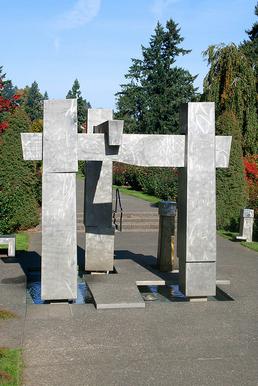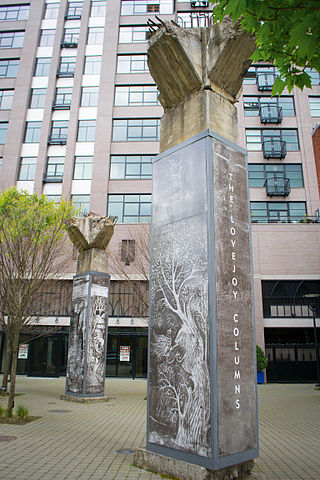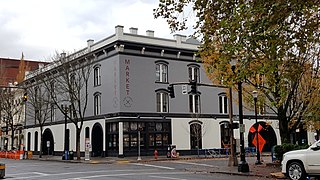
The Oregon Zoo, originally the Portland Zoo and later the Washington Park Zoo, is a zoo located in Washington Park, Portland, Oregon, approximately 2 miles (3.2 km) southwest of downtown Portland. Founded in 1888, it is the oldest zoo west of the Mississippi River.

Old Town Chinatown is the official Chinatown of the northwest section of Portland, Oregon. The Willamette River forms its eastern boundary, separating it from the Lloyd District and the Kerns and Buckman neighborhoods. It includes the Portland Skidmore/Old Town Historic District and the Portland New Chinatown/Japantown Historic District, which are listed on the National Register of Historic Places. It has been referred to as the "skid row" of Portland.

The Skidmore Fountain is a historic fountain in Portland, Oregon, United States.
Packy was an Asian elephant at the Oregon Zoo in Portland, Oregon, United States. He was famous for having been the first elephant born in the Western Hemisphere in 44 years. At the time of his death, he was the oldest male Asian elephant in North America. With a shoulder height of 10 feet 6 inches (3.20 m) and overall height of more than 12 feet (3.7 m) when standing up straight, Packy was also one of the tallest elephants in the United States and perhaps one of the tallest worldwide.

The White Stag sign, also known as the "Portland Oregon" sign, is a lighted neon-and-incandescent-bulb sign located atop the White Stag Building, at 70 NW Couch Street in downtown Portland, Oregon, United States, facing the Burnside Bridge. The sign faces westbound traffic as it enters downtown Portland coming across the Willamette River. The sign was acquired by the City of Portland in September 2010, and the lettering was changed to read "Portland Oregon" in November 2010.

William Sumio Naito was an American businessman, civic leader and philanthropist in Portland, Oregon, U.S. He was an enthusiastic advocate for investment in downtown Portland, both private and public, and is widely credited for helping to reverse a decline in the area in the 1970s through acquiring and renovating derelict or aging buildings and encouraging others to invest in downtown and the central city.

Povey Brothers Studio, also known as Povey Brothers Art Glass Works or Povey Bros. Glass Co., was an American producer of stained glass windows based in Portland, Oregon. The studio was active from 1888 to 1928. As the largest and best known art glass company in Oregon, it produced windows for homes, churches, and commercial buildings throughout the West. When the firm was founded in 1888, it was the only creative window firm in Portland, then a city of 42,000 residents.

The Merchant Hotel, also known as the Merchants' Hotel, is a historic former hotel building in Portland, Oregon, United States. It is located at 121 N.W. Second Avenue in Old Town Chinatown. It is a contributing property in the Portland Skidmore/Old Town Historic District, which was listed on the U.S. National Register of Historic Places in 1975 and designated a National Historic Landmark District in 1977. It is one of the few remaining examples of Victorian Italianate, cast iron architecture on the West Coast. It occupies half of a city block, specifically along the south side of N.W. Davis Street from Second to Third Avenues.

Shemanski Fountain, also known as Rebecca at the Well, is an outdoor fountain with a bronze sculpture, located in the South Park Blocks of downtown Portland, Oregon, in the United States. The sandstone fountain was designed in 1925, completed in 1926, and named after Joseph Shemanski, a Polish immigrant and businessman who gave it to the city. Carl L. Linde designed the trefoil, which features a statue designed by Oliver L. Barrett. The sculpture, which was added to the fountain in 1928, depicts the biblical personage Rebecca. Shemanski Fountain includes two drinking platforms with three basins each, with one platform intended for use by dogs.

The Frank E. Beach Memorial Fountain, officially titled Water Sculpture, is an abstract 1975 stainless steel fountain and sculpture by artist Lee Kelly and architect James Howell, installed in Washington Park's International Rose Test Garden in Portland, Oregon. The memorial commemorates Frank E. Beach, who christened Portland the "City of Roses" and proposed the Rose Festival. It was commissioned by the Beach family and cost approximately $15,000. Previously administered by the Metropolitan Arts Commission, the work is now part of the City of Portland and Multnomah County Public Art Collection courtesy of the Regional Arts & Culture Council.

The Chiming Fountain, also known as Cupid's Fountain, the John Staehli Fountain, Portland's City Park Fountain and Washington Park Fountain, is an outdoor cast iron fountain and sculpture built in 1891 by John "Hans" Staehli. It is installed in Washington Park in Portland, Oregon, United States. The fountain's name derives from the sound made when water drips from the upper basin. Staehli designed the fountain to serve as a watering trough for horses pulling carriages into the park. Based on a Renaissance fountain, it was originally painted white and included a statuette of a boy, possibly depicting Cupid, though the figure was damaged and permanently removed from the sculpture before or during the 1940s.

The Lovejoy Columns, located in Portland, Oregon, United States, supported the Lovejoy Ramp, a viaduct that from 1927 to 1999 carried the western approach to the Broadway Bridge over the freight tracks in what is now the Pearl District. The columns were painted by Greek immigrant Tom Stefopoulos between 1948 and 1952. In 1999, the viaduct was demolished but the columns were spared due to the efforts of the architectural group Rigga. For the next five years, attempts to restore the columns were unsuccessful and they remained in storage beneath the Fremont Bridge.

Hung Far Low was a Chinese restaurant in Portland, Oregon's Old Town Chinatown neighborhood, in the United States.

The United Carriage and Baggage Transfer Building is an historic building in Portland, Oregon's Old Town Chinatown neighborhood, completed in 1886. It is a contributing property in the Portland Skidmore/Old Town Historic District, which was listed on the U.S. National Register of Historic Places in 1975 and designated a National Historic Landmark District in 1977. Its ground floor currently houses the Pine Street Market.

Ankeny Plaza, is a historic square located at the intersection of Southwest Ankeny and Naito Parkway in Portland, Oregon's Old Town Chinatown neighborhood, in the United States. It contains Skidmore Fountain.

The Blagen Block is an historic building in Portland, Oregon's Old Town Chinatown neighborhood, in the United States. The four-story building was designed by Warren H. Williams and completed in 1888. In 1970, the city's Historic Landmarks Commission designated the Blagen Block as a Portland Historic Landmark. In 1975, it was listed as a primary landmark in the National Register of Historic Places (NRHP) nomination of the Portland Skidmore/Old Town Historic District, the building's designation subsequently translated to "contributing property" under post-1970s NRHP terminology. Since 2014, Airbnb has had offices in the building, opening its office in December of that year.
The Theodore Roosevelt Memorial is a lost monument and sculpture commemorating the 26th president of the United States, Theodore Roosevelt, as well as veterans of the Spanish–American War. It was originally installed in Portland's Battleship Oregon Park. Designed by American artist Oliver L. Barrett, the 18-foot (5.5 m) memorial was erected in 1939, but disappeared in 1942 after being relocated temporarily during the construction of Harbor Drive. It featured a geometric tufa statue depicting a man not resembling Roosevelt, as well as a smaller realistic sculpture of him. The monument initially received a generally unfavorable reception, but was considered one of Barrett's best-known artworks.

The Republic Cafe and Ming Lounge are a Chinese restaurant and bar in Portland, Oregon's Old Town Chinatown, in the United States. The restaurant is one of Portland's oldest, established in 1922, and continues to operate under the Mui family's ownership. Serving Chinese cuisine such as Mongolian beef, General Tso's chicken, chop suey, and egg foo young, the Republic Cafe has been described as a "staple" of the neighborhood and the city's Chinese American history. Celebrities have visited the restaurant which has also seen several longtime employees. Ming Lounge is among the city's oldest bars and has been characterized as "seedy".

The Portland Skidmore/Old Town Historic District is an historic district in Portland, Oregon's Old Town Chinatown neighborhood, in the United States. The approximately 20-block area, center around Burnside Street and named after the Skidmore Fountain, is known for exhibiting Italianate architecture, though High Victorian Italianate, Renaissance Revival, Richardsonian Romanesque, and Sullivanesque styles are also present. In addition to Skidmore Fountain, structures within the district's boundaries include the Blagen Block, Delschneider Building, Hallock and McMillin Building, New Market Theater, New Market Alley Building, New Market Annex, and Poppleton Building.


















